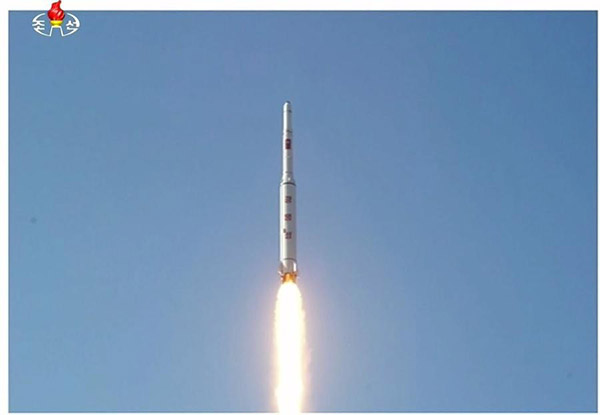Tensions and arms, rising swiftly on the Korean Peninsula
By Cai Hong (China Daily) Updated: 2016-09-12 07:56
 |
|
Democratic People's Republic of Korea launches a long range rocket launched into the air in this file still image taken from KRT video footage, released by Yonhap on February 7, 2016. [Photo/Agencies] |
The Democratic People's Republic of Korea conducted its fifth and biggest nuclear test on Friday, when the country observed the 68th anniversary of its founding, and it claimed it has mastered the ability to mount a warhead on a ballistic missile.
In a statement issued on Friday, the United Nations Security Council strongly condemned the DPRK's latest test, calling it a clear threat to international peace and security.
The DPRK has sped up development of its nuclear and missile programs this year-in UN Secretary General Ban Ki-moon's words, an "accelerating spiral of escalation"-in defiance of several Security Council resolutions.
Its provocative acts have made the situation on the Korean Peninsula and in East Asia more complicated, offering a ready pretext for Japan, the Republic of Korea and the United States to make joint and individual military deployments.
US President Barack Obama spoke by phone with ROK President Park Geun-hye and Japanese Prime Minister Shinzo Abe on Friday, with the three agreeing to take "additional significant steps, including new sanctions" against the DPRK.
The ROK and Japan joined the US in a joint missile defense drill in June off the coast of Hawaii-the three countries' first maneuver focused on tracking and defending against the DPRK missile launches-on the sidelines of RIMPAC, the Rim of the Pacific Exercise, which is the world's largest international maritime warfare exercise.
The US, the ROK and Japan have also started a new initiative to share military intelligence on the DPRK's ballistic missiles after the DPRK fired three midrange ballistic missiles in August that landed in Japanese territorial waters.
Wariness made Seoul cancel an agreement to share intelligence with Tokyo at the last minute in 2012. Now the DPRK's nuclear and missile programs have pushed the two estranged US allies to join hands. The defense ministers of Japan and the ROK also talked on the phone on Saturday, agreeing to cooperate closely and with the US in dealing with the DPRK's nuclear program.
Still, each of the three allies is making its own moves.
On July 29, the US Air Force said it would upgrade its hardware on Guam by sending the B-1 for the first time since April 2006, providing US Pacific Command and its regional allies and partners with "a credible, strategic power projection platform".
On Aug 31 Japan's defense ministry submitted a request for a record budget of $50.12 billion for the fiscal year starting April 2017. If approved by Japan's parliament that will convene on September 26, the country's defense spending will be up by 2.3 percent-the fifth increase in a row since Abe took office for the second time in late 2012.
The budget request includes $1 billion to upgrade a dozen of Japan's PAC-3 surface-to-air missile defense systems so as to increase their range and accuracy for deployment in 2020.
The ROK, meanwhile, announced it will deploy THAAD, the US' Terminal High Altitude Area Defense anti-missile system by the end of this year despite strong protests from China and Russia.
China and Russia take the deployment of THAAD in the ROK as a threat to their own security, and say that it will do nothing to bring the DPRK back to the negotiating table.
Russia's foreign ministry warned that the THAAD deployment would spark an arms race in the region and complicate the resolution of the nuclear problem on the Korean Peninsula.
Tensions are rising in the delicately balanced region, and distrust is building up. This is an alarming scenario.
The author is China Daily Tokyo bureau chief.
caihong@chinadaily.com.cn












